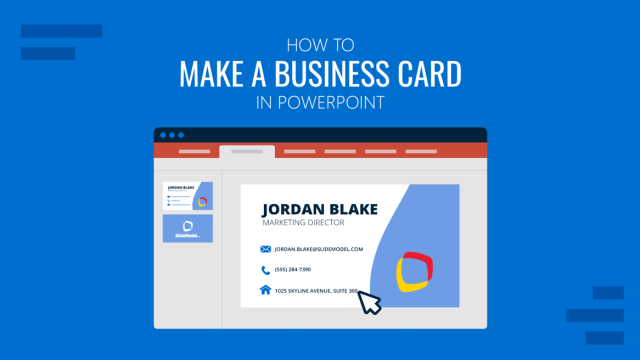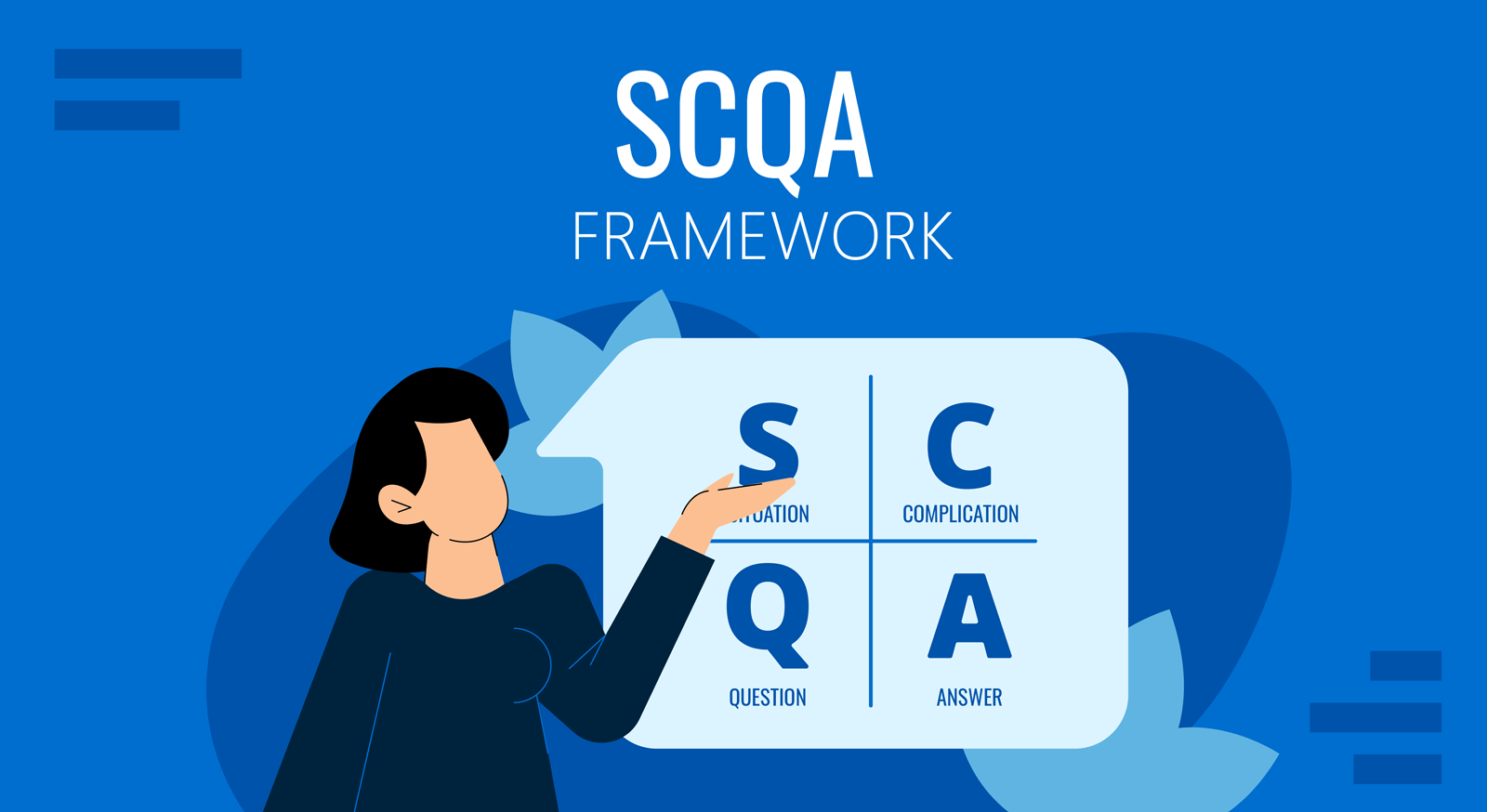
Structuring information is just as important as gathering the required details to form a narrative. Your message should be structured to make your content easy to understand, with clarity regarding what is to be discussed. The SCQA framework by Barbra Minto provides a logical flow to structure your message. Let us show you how you can make your message more engaging using SCQA.
What is SCQA?
SCQA stands for situation, complication, question, and answer. This is a logical flow to structure your message to make it engaging for the reader. SCQA has a wide range of applications, particularly in communication-related to business.
Here are the key elements of the SCQA Framework:
| Element | Explanation |
|---|---|
| Situation | Describe the current situation or background. |
| Complication | Explain what problem or change has come up. |
| Question | Ask the key question that needs an answer. |
| Answer | Give a clear, logical and direct solution to the question. |
Be it a presentation, report, email, or value proposition, using SCQA can make the message more attractive to the reader and result in a favorable outcome. For example, a potential client follows up on your call to action because the message appears compelling. Similarly, you can use SCQA to structure your pitch deck to grab the attention of a potential investor or use the framework to structure your reports to make them easier to read for the reader.
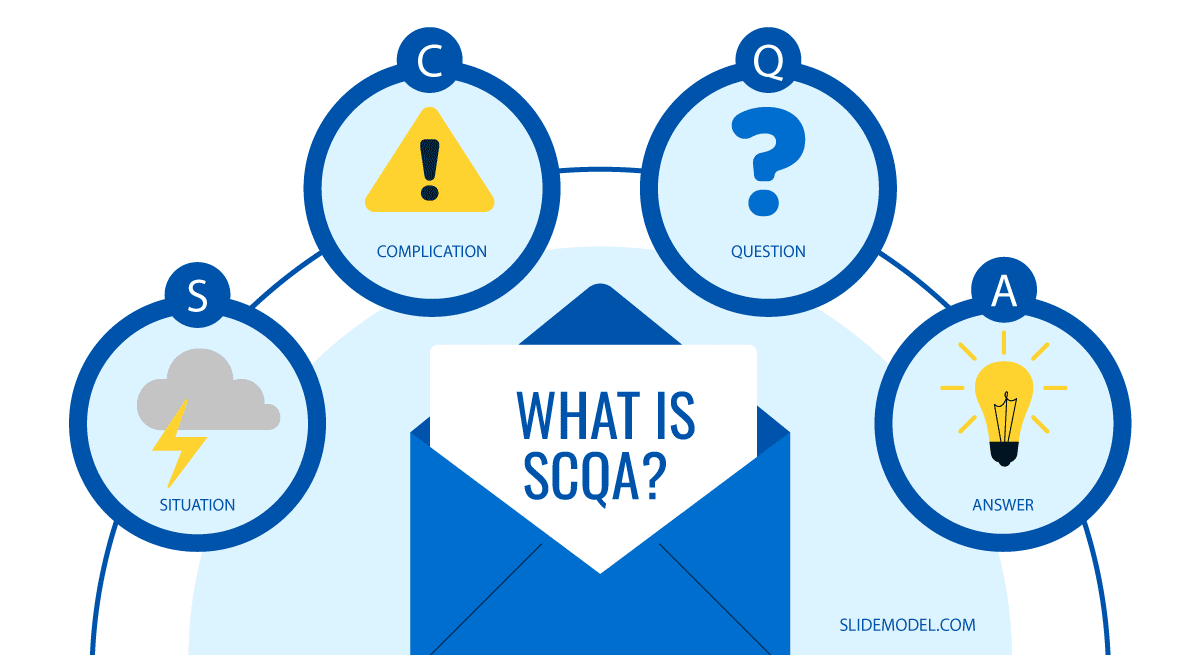
Situation
The situation is a part of the flow of information that comes at the very beginning. This contains agreed points and information that is recognizable. This is the part where you also define the problem and state the set of facts related to the current situation. Let’s assume you are presenting a PowerPoint pitch deck for an app that tracks the customer journey to help boost sales using e-commerce platforms. In such a case the situation would include well-established facts related to e-commerce and the customer journey and the need for efficient software to track it for boosting sales.
Complication
A complication in the SCQA framework is the problem that you are working on or the change in circumstances. It is the reason for your entire narrative. A complication can be a result of both an internal or external change. This should be well defined in the narrative.
A presenter delivering a pitch deck has a bright idea that can help solve a problem by providing a useful product or service. Similarly, a client reading a compelling ad is there because he or she wants something. In order to make a compelling case for the call to action, you need to define the problem well enough to attract the consumer.
Question
The question identifies your hypothesis regarding the solution. If you are presenting a pitch deck before a potential investor, you need to pose questions regarding the complication. Perhaps you have a product that can boost sales and result in a long-term profit if the investor provides you with the required funding. Maybe the product you are producing is one of a kind and the demand for it can be immense in the market. Let’s assume you need funding for your app that can provide analytics regarding the customer journey for an e-commerce website. In such a case you might want to ask questions about the efficiency of existing analytical software and how they fall short of expectations.
Answer
The answer in the SCQA model is the response to the questions you have asked. It is important to provide compelling answers. These answers might not be the definitive truth but answers to the questions posed by you during your narrative. If you are offering investors a chance to invest in a promising venture, you cannot guarantee success but there is a good amount of chance that the investment is going to pay off.
Sticking to our example of an analytical software capable of boosting sales via e-commerce platforms, you can present your app as a solution to the question asked in the previous section. This is an example of how an answer can help structure your message using SCQA.
Barbara Minto’s Pyramid Principle and SCQA Framework
The SCQA framework was developed by Barbra Minto, who was also the developer of the Pyramid Principle. As explained in our previous post, the Pyramid Principle provides the answer at the beginning, followed by supporting arguments, which are then followed up with data and facts. This enables the audience to see the supporting argument, data, and facts in light of the hypothesis presented at the start. Allowing for a better analysis of the hypothesis itself.
The SCQA framework, unlike the Pyramid Principle, presents the answer at the very end. It begins with the current situation, the problem, the question regarding the core issue, followed by your solution for the problem. This is more of a conventional approach towards presenting your message, albeit in a more refined manner.
Examples of using SCQA to Structure Your Message
When using the SCQA framework, you can structure your message for a variety of purposes. Since the framework is widely used for business writing, it can be used in everything from your reports and PowerPoint presentations to emails, storyboards, product descriptions, and value propositions.
Using SCQA in Presentations
SCQA can be used for virtually any type of presentation, especially business presentations. Let’s say you are presenting a presentation regarding the results of a recent investment by your organization in a new market before the senior management and want to make the flow of information more structured. Using SCQA, you can start with the situation, present the complication, ask relevant questions, and provide the solution.
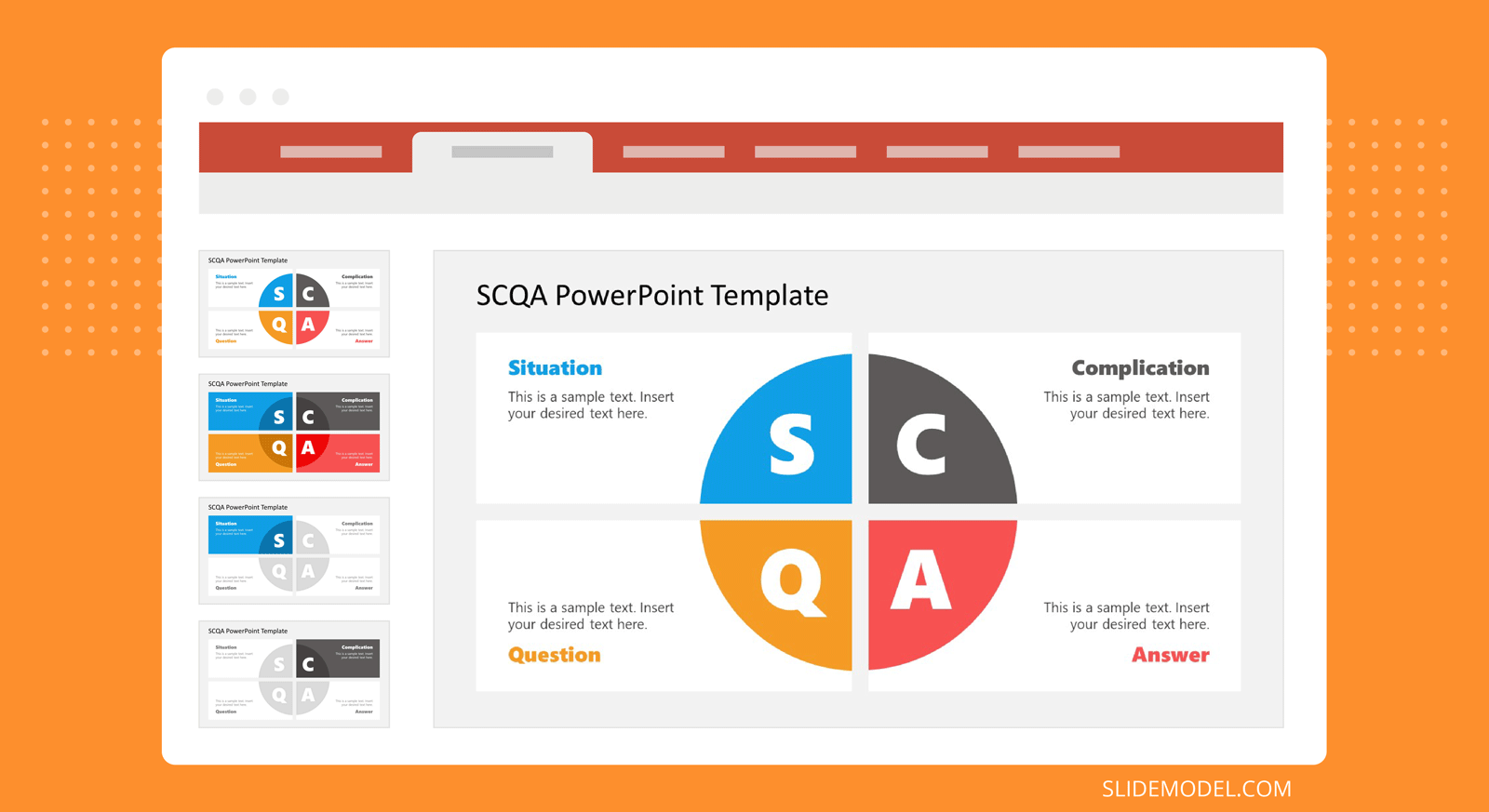
Example: You work for a telecom company that recently invested in a country in South Asia with a growing telecom user base. It has been a year since the investment and the company only has a 5% market share. A recent user survey has yielded some compelling results that might help the company identify the issue.
For this example, using the SCQA framework you first need to state the situation, i.e. the investment of the company in a promising market. You can also present a few key figures to show the sales performance. This will lead you towards the complication, the inability of the company to attract a sizeable number of consumers despite being in the market for a year. This will be followed by the question. In this case, a suitable question can be; ‘why aren’t consumers interested in the service of your company compared to competitors?’.
The answer can be presented at the end with a solution. In our example, a user satisfaction survey identified that competitor telecom companies have been offering more compelling rates. While many consumers rated the voice quality of the company to be better than competitors, the call and internet bundles are a bit expensive. The answer, in this case, would be to present a pricing structure that can help the company attract customers, complemented with a compelling marketing campaign that can help make the new packages a hit with customers.
Using SCQA to Structure an Email
Many people might not think much about their communication via email. However, presenting complex information in a few lines and using the right words can make a world of difference. Using the right structure and tone can save you from miscommunication and provide your message with clarity.
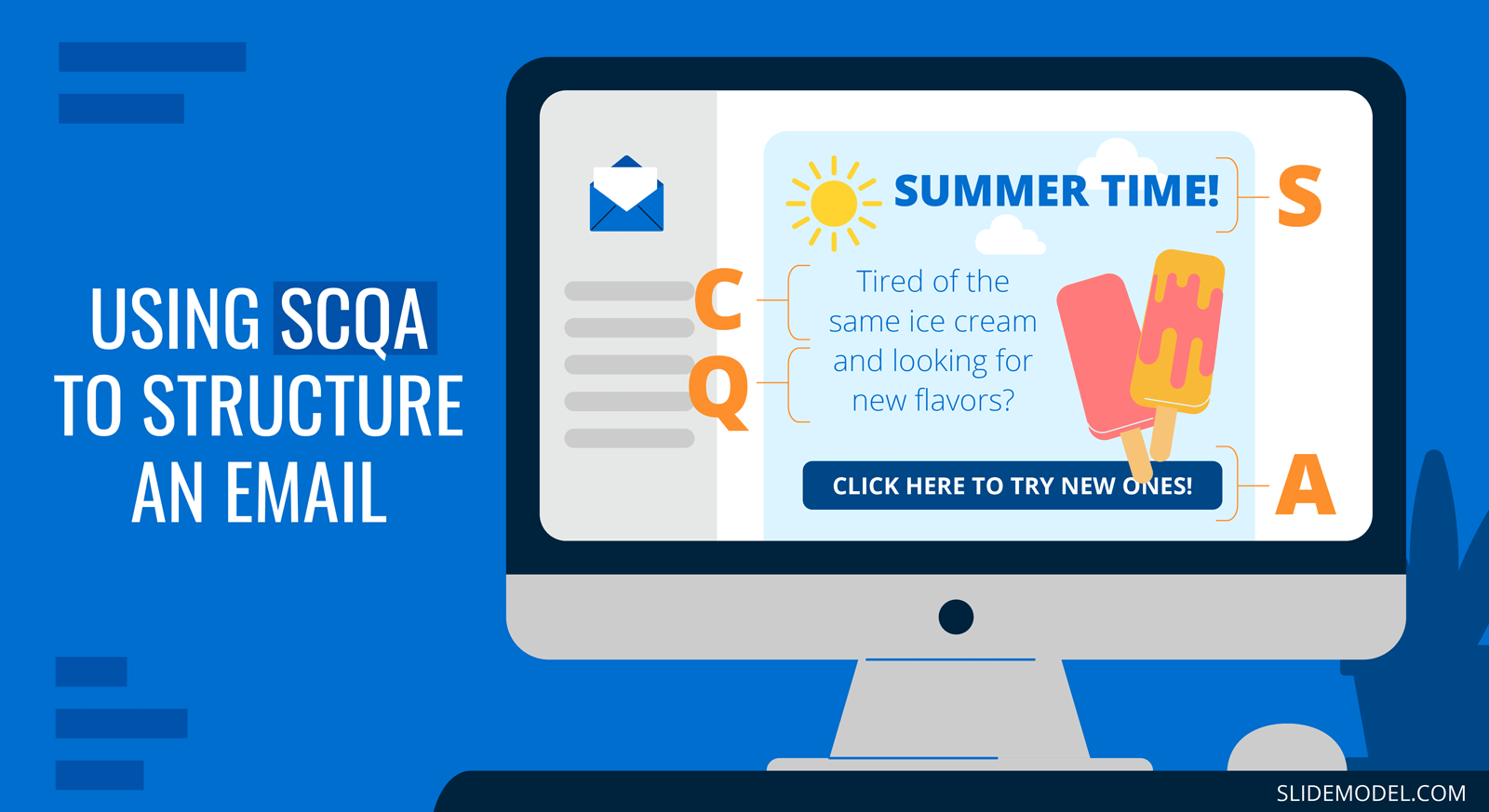
Example: You are writing an email that will be sent to customers who have subscribed to your monthly newsletter. You want to write something related to the new ice cream flavors your company has launched and want to encourage people to buy them.
When writing an email, be it for marketing purposes or informing customers regarding a new product, the basic structure would include stating the situation, e.g. it’s time for summer and people are looking to satisfy their ice cream cravings. The complication is that people might be tired of the old flavors and want something fresh. You can pose the question whether the customers would be interested in new and delicious flavors? The answer would be your new flavors mentioned at the end with a call to action.
Using SCQA to Improve Reports
One of the banes of reporting is the difficulty they can pose in making them cohesive and easy to understand amidst endless charts, tables, and figures. SCQA can help you uncomplicate your reports.
Example: Let’s say you have to create a report based on a consumer satisfaction survey your company conducted. Such a report can be difficult to interpret and boring for the reader under normal circumstances. By using SCQA, you can structure it to start with the basic information regarding the current situation, i.e. where does your company stand in terms of market share, revenue, and how does it currently fare in the target market. This can be followed by the issue at hand, e.g. stagnation in the market.
You can pose questions that might be relevant to the situation to ask as to why the market has stagnated for your business. The answer at the end can be the key findings from the survey, such as a dip in satisfaction of the consumers or perhaps their preference for a competitor product with more features.
Using SCQA to Write a Value Proposition or Product Descriptions for E-commerce
Value propositions or product descriptions can be structured using SCQA just like any other message. When making such a description for e-commerce, you can make use of analytical data to map the customer journey to make your description more compelling.
Example: You are an employee at an e-commerce company tasked with writing a compelling product description for PowerPoint templates sold via your website. You can start with what the product is about, i.e. premium PowerPoint templates, describe the complication. This can be the lack of quality templates for people looking to create presentations with accurate maps. Something that your company specializes in producing.
You can pose questions like; ‘are you looking for an Animated Map PowerPoint Template for a country, continent, or regions?’. This can be followed by the answer that your company provides premium, animated map templates for every country, continent, and various regions. You can mention features that make your service stand out, such as the fact that other than countries and continents, your website also provides customers access to editable map templates for EU countries, the SAARC region, the Middle East, etc.
Using SCQA for Storyboarding
The SCQA framework is pretty close to storyboarding your message to build a compelling narrative. This can be literally translated into a storyboard just as easily.
Example: You are making a storyboard for an Android app that is meant to educate children about preventive measures to take when going to school to avoid contracting COVID-19. In this case, you can describe the current state of the pandemic, the problem of living with the COVID-19 pandemic until it can be tackled in a better way with new research and medicines, pose questions around safety, and then show multiple-choice questions to test the knowledge of the user with a rating-based system. The answers revealed at each stage will be informative for the user to test how accurate their knowledge is regarding COVID-19 and preventive measures to take at school, while also revealing the answer.
SCQA PowerPoint Templates
To present the SCQA framework or to structure your message using it, you can use the following PowerPoint templates to present your content using compelling layouts, infographics, and sequential slides to explain each section of the framework. the SCQA templates listed below come with editable objects that can help you design your presentation slides with the visual aid of customizable slide layouts that can be adjusted to your liking.
Final Words
The SCQA framework can be a great way to structure your message. By using this four-step framework, you can inform the recipient of the message regarding the existing situation, the issue or complication, pose important questions, and provide a solution. The SCQA framework is not meant to provide a silver bullet to answer all questions but to offer a direction that can be further debated. Like the Pyramid Principle, SCQA can be a good starting point for important discussions, as well as a better way to identify solutions to complex problems.

